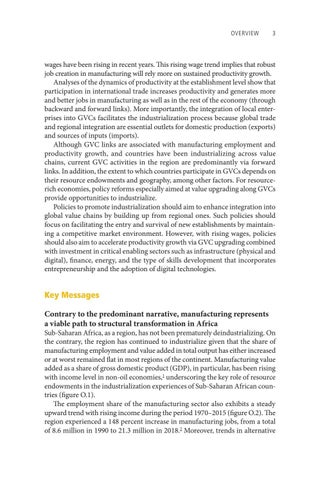OVERVIEW 3
wages have been rising in recent years. This rising wage trend implies that robust job creation in manufacturing will rely more on sustained productivity growth. Analyses of the dynamics of productivity at the establishment level show that participation in international trade increases productivity and generates more and better jobs in manufacturing as well as in the rest of the economy (through backward and forward links). More importantly, the integration of local enterprises into GVCs facilitates the industrialization process because global trade and regional integration are essential outlets for domestic production (exports) and sources of inputs (imports). Although GVC links are associated with manufacturing employment and productivity growth, and countries have been industrializing across value chains, current GVC activities in the region are predominantly via forward links. In addition, the extent to which countries participate in GVCs depends on their resource endowments and geography, among other factors. For resourcerich economies, policy reforms especially aimed at value upgrading along GVCs provide opportunities to industrialize. Policies to promote industrialization should aim to enhance integration into global value chains by building up from regional ones. Such policies should focus on facilitating the entry and survival of new establishments by maintaining a competitive market environment. However, with rising wages, policies should also aim to accelerate productivity growth via GVC upgrading combined with investment in critical enabling sectors such as infrastructure (physical and digital), finance, energy, and the type of skills development that incorporates entrepreneurship and the adoption of digital technologies.
Key Messages Contrary to the predominant narrative, manufacturing represents a viable path to structural transformation in Africa
Sub-Saharan Africa, as a region, has not been prematurely deindustrializing. On the contrary, the region has continued to industrialize given that the share of manufacturing employment and value added in total output has either increased or at worst remained flat in most regions of the continent. Manufacturing value added as a share of gross domestic product (GDP), in particular, has been rising with income level in non-oil economies,1 underscoring the key role of resource endowments in the industrialization experiences of Sub-Saharan African countries (figure O.1). The employment share of the manufacturing sector also exhibits a steady upward trend with rising income during the period 1970–2015 (figure O.2). The region experienced a 148 percent increase in manufacturing jobs, from a total of 8.6 million in 1990 to 21.3 million in 2018.2 Moreover, trends in alternative

